Entries Tagged 'Family stories' ↓
January 20th, 2009 — Family stories, Mauritius
In today’s issue of Forbes Joel Kotkin writes on the family values of Obama as a model of proper parenting and spirituality for the next generation. In the same line of thoughts, since my last family meeting, both my family nucleus and the extended Yiptong family, I lived in December last, my quest is on the transmission of family values to my grand children.
What are family values?
What exactly makes up a strong family that possesses good family values? A strong family is one that sustains its members — that supports and nourishes the members throughout the span of that family.
|
What exactly makes up a strong family that possesses good family values? A family that sustains its members — that supports and nourishes the members throughout the span of that family. A strong family unit creates a safe, positive and supportive place for all members to thrive. They are able to utilize resources and to live together in a fairly healthy manner.
The adults in a strong family set the tone. They are good role models that lead by example. They reach out to friends and community and teach their children the importance of doing the same — and that becomes part of who the children are. They work together to solve problems, and they pass their skills on to the next generation. Some important elements of a strong family system are family cohesion, family flexibility and family communication.
Cohesion- In families cohesion would be defined as the feeling of being loved, of belonging to the group and being nurtured by it. Although closeness is good in a family unit, there must be a balance between being together and being separate. A person must be able to develop their individuality, while being supported and confident within the family. A few things that bring a family together are the commitment of other family members, and the spending of time together.
Flexibility- There must be a structure in a family or it will become chaotic and will not be a peaceful setting for a family. Conversely, there must be flexibility or the family becomes rigid and the authority figures become resented. We could compare a successful family to a democracy. There are leaders, but the whole group is involved in the decision making process. Although the leaders are in charge all members develop the ability to cope with stress, and at times lead. While the family works to avoid stressful situations they work together to solve problems, without blaming, criticizing and finding fault with each other. Families that tend to have a strong spiritual base seem to have a sense of well-being that facilitates this working together in times of stress.
Communication- Ever hear the saying, “What we have here is a failure to communicate?†A lack of communication can rip a family apart and destroy them. Things that facilitate communication are the things mentioned so far — family closeness, flexibility, time spent together, spirituality. All members must feel a freedom within the group to express themselves freely.
Another very important factor is the relationship between the “head†couple. In a family that is parented by a happily married couple, people are able to express themselves more freely. What they might say isn’t filtered through the problems of the “guardians.†A happy marriage seems to set the tone in the house. It spills over from the family to the community and a healthy family will be reaching out to help others. They do not tend to isolate themselves from the rest of the world.
A very important thing for families to teach their children is how to make good decisions. If they have watched their parents making well thought out decisions over the years, they will tend to be good decision makers themselves.
A healthy, happy family benefits our whole society. Among the children of strong families there is less crime, less divorce and less emotional problems. They tend to go on and have strong, healthy families of their own, having learned from their folk’s example.
|
|
|
I reproduce here an interview which was conducted this week.
Carl Anderson was in Mexico City last week to address the VI World Meeting of Families, which was attended by some 10,000 participants. His address Friday was titled “Solidarity and Family.”
Anderson took some time to speak with ZENIT about his address on the concept of solidarity, his impressions of the world encounter, and what he sees as the greatest challenge for the Christian family today.
Q: The topic of your conference was “Family and Solidarity.” Why solidarity?
Anderson: The short answer is that’s the topic they gave me. But this is such an important term for John Paul II. Obviously because of what happened in Poland and in Eastern Europe in the 1980s and 1990s, but more especially I think as part of his vision of renewal for the Church and for society.
Understanding that solidarity in the Christian sense is really understood as a communion of being for others, and that was so central to John Paul II in terms of the theology of the body and his whole understanding of the human person as being connected to other people. So this is the idea of solidarity in the family, and then the family as a model for the greater society of witnessing communion and solidarity, and living a life for others: first in the family, but then outside in the community of larger society.
Q: You went from the idea of unity, drawing on the thought of John Paul II, and then spoke of solidarity, drawing on the thought of Benedict XVI. How did you come to that conclusion?
Anderson: Well, what’s so remarkable to me, although perhaps in the wisdom of Providence it’s just part of what ought to be, [is that] obviously John Paul II and Benedict XVI are two different individuals — they have two different specialties and interests — but there is such a parallel between their two ways of thinking. To see Benedict XVI compliment and build upon this whole idea that John Paul II introduced in terms of solidarity, and unity and communion of persons and what that means, and to see Benedict XVI advance it and broaden it and deepen it, just shows the continuity in Church teaching, and the tradition and life of the Church. So, it is a wonderful thing and I think we are very lucky to have these two great Popes in the history of the Church.
Q: The idea of solidarity in the family seems to be something that happens almost spontaneously. Do you see that solidarity as something that is natural in society, but nevertheless something that is disintegrating?
Anderson: I think that one of the most important insights of John Paul II is this idea that these are not just ideas, but it’s actually built into the very structure of human existence by the Creator as part of his design. If we look at the two great commandments — love of God and love of neighbor — love is built into the very vocation of the human person, at the very center. And therefore it shouldn’t surprise us that the structure of human existence is designed in such a way to lead us to that kind of relationship with each other. And that is one of the most important contributions I think that John Paul II made to the ongoing teaching of the tradition of the Church, and I think that it’s something that we’re only now beginning to see how important it is and what the broad implications are.
Q: What are the major challenges you see for the family in the United States today?
Anderson: Well, it’s hard to know where to begin. Certainly there are the obvious economic, social and cultural pressures. But I think the great challenge that the Christian family faces is to encounter what it means to be a Christian. What it means to say that Jesus is Lord. And to believe what we say in the Creed, and to live that life first within the family, and then outside in greater society. To be a true witness.
Forty years ago, Father Joseph Ratzinger, speaking to a group of students, said that what troubles so many Christians more than the question of whether God exists, is the question of whether Christianity makes a distinctive difference — whether there is something new in society that we look around and we can see, resulting from Christianity. And this kind of distinctive witness, I think, is a challenge that Christian families face, fundamentally.
Is there a difference between the secular society and the way Christians marry, beget their children, raise their children, educate their children, the way they work, the way they treat their employees, the way they treat their customers and the way they vote? Or is it indistinguishable from the secular society?
If it is indistinguishable, then we go back to Father Ratzinger’s great question, then what did Jesus Christ bring that was new? So I think that’s the challenge of Christian families.
Q: President-elect Barack Obama will be taking office Tuesday. Many in the United States see his inauguration as a turning point for the country. What do you see ahead for the United States in 2009?
Anderson: I think much of the press — present company excluded — swings back and forth to extremes. And I think the expectations now for President-elect Obama are very, very high. The challenges that the United States and the world faces are so great that it requires everyone to be committed to finding solutions and working together to find solutions that make sense.
But, from his campaign rhetoric, especially on family issues, on social issues, on pro-life issues, if he moves forward in that direction, it will present very great challenges to many believers who recognize the sanctity of life, whether they are Catholics or Protestants, or Jews — even nonbelievers, to some extent. So I think the expectations are tremendously high for the new president, and everybody wishes that he will find some way out of many of the economic and foreign policy issues.
Q: One last question. What should someone who is participating physically or spiritually in this event take away from the VI World Meeting of Families?
Anderson: The future of this society depends upon the family, the future of the family. This is the decisive place of encounter between the Church and culture today. Therefore the witness of Catholic families must be authentic, they must be very strong, and it must be one that its surrounding community can see.
And it must be one which reflects, and I think Pope Benedict has done this in a tremendous way, reflects the joy of being a follower of Jesus Christ, so that people who are not Christians can look at the Catholic family and say, that’s a way of living that I would like to have, that I would like to participate in. It’s not a series of no’s, it’s a series of yes’s, and it’s a joyful way of living, and it’s a fulfilling way of living. And I want to be a part of that.
January 14th, 2009 — Chinois, Family stories, Mauritius, Uncategorized
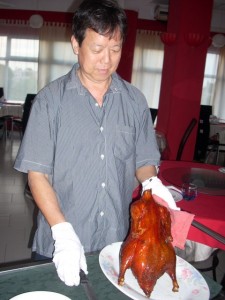
As we move into the Chinese New Year period which this year will be on the 26th January, the rejoicing and joyful parties continue on. Last week end, a great dinner party with the relatives was followed the next day by the Thanks giving dinner ( Van Shin ) of the Chan clan organised the Oy Kin Sa society. Monday evening was another great Peking Duck dinner with my wife’s relatives. I have to restraint my eating in the face of such rich and appetising dishes. More delicious dinners are on for the coming weeks!
I posted on my face book the dishes I had at the Van shin dinner which were typical Hakka dishes: Steam Chicken through Shark fins soup to dried vegetable stew belly pork. Some of my overseas friends on seeing the photos were dying for these dishes. As a dream the flavour and smell were oozing out of the slight blurred pictures and creating induced gastric stimulation of the stomach. From Norway: “all smells very good, but pictures are a little blurry.”From Montreal Canada: comment about your photo in the album “Chinese Hakka meal @ King Palace”:”ayo to faire moi gagne faim!”

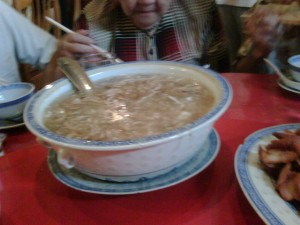
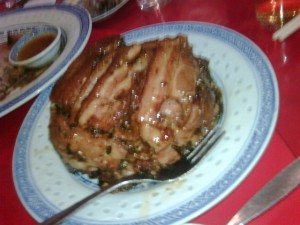
December 27th, 2008 — Chinois, Family stories, Uncategorized
When I tell my non Chinese friends that I have the family history back for 24th generations, they are amazed. The reality is that my ancestors had the fore sight of planning their descendants. I rejoiced on reading an article published on L’Aurore, the Catholic Mission monthly magazine December issue No 125, by one of my distant cousins of the same clan Chin who explained how generations’ names were generated. Just like YIP TONG does not carry the clan name, the author of the article Leung Shing names was truncated by the civil status officers of the time when our ancestors landed in Mauritius.
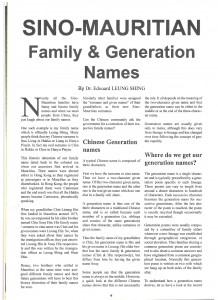
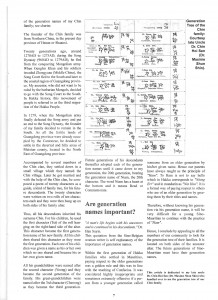
December 26th, 2008 — Family stories, People, Reflexion
Having spent a week with my lovely grandsons and listening to them, it occurred to me that physical punishment might be an issue for them.
What is the alternative to corporal punishment in child rearing?
Whilst many of us need to instil discipline in our children, we should refuse to use physical punishment. Sanderson Beck does give some alternatives in his literature.
If disciplining is necessary in child-rearing, but we wish to avoid the harmful effects of corporal punishment, what are our alternatives? By refusing to use physical punishment, perhaps we can refine and develop those other techniques which may prove more beneficial and enduring than the easy and quick brutality. Punishment does not have to be physical; it can be social, emotional, or mental. One form of punishment is the administering of an aversive stimulus contingent upon disapproved behavior The other is the removal of a reward or positive reinforcer (Skinner, 1938). The undesirable consequences of punishment are primarily psychological, so it appears likely that non-physical psychological methods may also have negative effects psychologically. However, to avoid using any form of punishment whatsoever is probably too idealistic and impractical. The psychological methods are not as obvious in modeling. Also they are usually stimulating cognitively, and may stimulate the child to develop the mind just as much physical exercise builds muscles. The danger is that negative associations and complexes could result. This is why it is so important that the punishment not only be consistent in how and for what it is applied, but also that it be logical and clearly explained to the child before it is ever instituted and with each occurrence. Even though the child may feel the parent is wrong; if one is consistent, at least the child knows the situation and can learn to understand the psychology of the parent.
Using reasoning to accompany punishment when it is deemed necessary brings up the method of teaching and communicating as an alternative method. This is the ideal method of long-term control of behavior, because it develops the conscience, cognitive skill, and self-discipline. Wouldn’t it be the utopia if everyone took responsibility for their own actions and did not inflict on others? I believe that educators ought to use those methods that teach individual responsibility. Research shows that the development of conscience is related to parental warmth and the use of reasoning as a technique of discipline (Bandura & Walters, 1951; Baumrind, 1967; Sears, 1961). When the child has developed self-control and one’s conscience to the extent that one will no longer do what one knows is wrong even when one knows one won’t be punished, then we could say one’s character education has been successful.
November 13th, 2008 — Family stories
Yesterday, the cousins and friends of Florise flocked to church to attend a special mass celebrated for her. The 6 pm mass coincided with the burial ceremony which was held almost at the same time in London. I could not stop myself from thinking that there was a great communion of spirit between Florise’s family, the cousins in London , the friends and relatives gathered in Roche Brunes and the whole assembly of the parents who are ahead of us in the heavenly abode. I image from the perspective of the timeless world, where we would have become omniscience in our Lord, it would be a wonderful scene and feeling seeing this wonderful communion.
Florise,I cherished the delightful time we had together, particularly the heart to heart discussions we had during my past visits to London. Your great heart and joy de vivre will forever be engraved in my memory.You have been a great person, a wonderful cousin,faithful wife and mother but above all a christian who has suffered from dutifully accepting your fate. I admire your will power and persevrance,when at a late age you undertook to go back to your studies through the open university courses and your dedication to the under priviledged and service to the needy through your work.
And this morning on opening my mail, I have been given the Pope teachings on our life after life.
Farewell Florise..Adieu ma cousine….
The Pope said this today when he dedicated the weekly general audience to another instalment in his ongoing reflection on the life and theology of St. Paul.
After a consideration of how the Apostle’s interior freedom hinged on his faith in the resurrection of the dead to life in Christ, the Holy Father considered what the saint’s teaching encourages for Christians of the 21st century.
“The first attitude [for Christians],” he said, “is the certainty that Jesus has risen, is with the Father, and because of that, is with us forever. […] Because of this, we are secure and free of fear. This was an essential effect of Christian preaching. Fear of spirits and gods was spread throughout the entire ancient world. And today as well, missionaries find — together with so many good elements in natural religions — the fear of spirits and the ill-fated powers that threaten us. Christ is alive; he has overcome death and has overcome all these powers. With this certainty, with this freedom, with this joy, we live. This is the first element of our living directed to the future.”
The second attitude for faith-filled Christians is the certainty that Christ “is with me,” the Pontiff continued.
“And that in Christ the future world has already begun — this also gives the certainty of hope,” he said. “The future is not a darkness in which no one gets one’s bearings. It is not like that. Without Christ, also for the world today, the future is dark; there is fear of the future — a lot of fear of the future. The Christian knows that the light of Christ is stronger and because of this, lives in a hope that is not vague, in a hope that gives certainty and courage to face the future.”
But this certainty, Benedict XVI affirmed in noting the third attitude, in no way justifies an escape from responsibilities in the present life.
“We don’t live as if good and evil were the same, because God only can be merciful,” he explained. “This would be a deceit. In truth, we live with a great responsibility. We have talents, we have to work so this world opens itself to Christ, so that it is renewed. But even working and knowing in our responsibility that God is a true judge, we are also sure that he is a good judge. We know his face — the face of the risen Christ, of Christ crucified for us. Therefore we can we sure of his goodness and continue forward with great courage.”
Praying for the end
The Pope concluded the audience address with a reflection on a prayer that Paul taught: “Maranà , thà , which literally means, ‘Our Lord, come!'”
“Can we also pray like this?” the Holy Father asked. “It seems to me that for us today, in our lives, in our world, it is difficult to sincerely pray so that this world perishes, so that the New Jerusalem comes, so that the final judgment and Christ the judge come.”
But, he contended, there is a way in which modern Christians can join with their first predecessors in saying “Come, Lord Jesus.”
“Certainly, we don’t want the end of the world to come now,” the Bishop of Rome said. “But, on the other hand, we want this unjust world to end. We also want the world to be deeply changed, the civilization of love to begin, [we want] a world of justice and peace, without violence, without hunger, to arrive. We all want this — and how can it happen without the presence of Christ? Without the presence of Christ, a just and renewed world will never really arrive.”
Therefore, the Pope added, “though in another way, totally and deeply, we too can and should say, with great urgency and in the circumstances of our time, Come, Lord! Come to your world, in the way that you know.
“Come where there is injustice and violence. Come to the refugee camps, in Darfur and in North Kivu, in so many places in the world. Come where drugs dominate. Come, too, among those rich people who have forgotten you and who live only for themselves. Come where you are not known.
“Come to your world and renew the world of today.”
October 28th, 2008 — Family stories, People
Last night lying in bed I could not sleep as we had the summer time on board. I was ahead one hour of my usual bed time. So to occupy my mind pending the coming of ‘Mr. Sandman to bring me a dream’, I was thinking of the tunes and songs of my childhood. Who were my songs Idols? Who was the singer I loved most in my teens and can still remember the songs of?
There were so many of them: Cliff Richard, Elvis Priestley, The Beatles, Dean Martin, Adamo, Louis Mariano, Tino Rossi , Tom Jones and many others. We were music lovers in the family, ever since I was in the cradle, my father used to play the gramophone for me. From the old manual turntables, HMV (His master Voice) phonograph running 78 RPM records to the greater fidelity 45 RPM vinyl records and long play 33 RPM records, I enjoyed a great variety. I recall very vividly the first 45 RPM unbreakable record at home played on the electric ‘Garrard’ turntable: the title was ‘Are you mine’. Father himself a great music lover had an impressive collection of 78 RPM records.
It took me a while to select and conclude who was my first teenage song idol. I finally decided that it was Paul Anka. Paul Mustapha Abdi Anka, (Arabic: بول مصطÙÙ‰ عبدي أنكا) (born 30 July 1941, in Ottawa, Ontario) is a Canadian singer, songwriter, and actor of Lebanese origin. He came from a Christian Maronite family back ground. As many Lebanese, he fluently speaks Arabic, English and French.
Paul Anka first became famous as a teen idol in the late 1950s and 1960s with hits songs like “Diana,” “Lonely Boy,” and “Put Your Head on My Shoulder.” He went on to write such well known music as the theme for The Tonight Show Starring Johnny Carson, Tom Jones‘ biggest hit “She’s A Lady,” and the English lyrics for Frank Sinatra‘s signature song “My Way.”
He is still very much active professionally at age 67 and recently remarried.
The favourite’s songs of my teenage days were:
· “Diana” (1957)· “Crazy Love” (1958) · “You Are My Destiny” (1958)· “Lonely Boy” (1959)· “Put Your Head on My Shoulder” (1959) · “Puppy Love” (1960) . Those are indeed my favourite bathroom singing tunes.
October 27th, 2008 — Family stories, Reflexion
Nous avons en vu plusieurs mariages dans la famille. Déjà au mois de décembre, deux mariages sont annoncés : fils de mon cousin à Singapour et quelque jours après la fille de mon cousin à Maurice. Et encore d’autres mariages dans la proche année dans la famille seraient en préparation.
Le mariage est il qu’une affaire entre les futurs époux? Pourquoi alerter toute la famille et faire de l’événement une grande jouissance ? Quel est le but ‘d’officialiser’ l’alliance de deux êtres qui s’aiment et qui se promettent l’un à l’autre pour la vie ? Le mariage est ce qu’un acte juridique seulement ? Qu’a-t-il derrière cette promesse solennelle devant les hommes et Dieu ? Quels sont les engagements pris devant la société et Dieu ? Quel impact sur les engagés, la famille, la société, l’église ?
Dans la tradition le mariage était un événement purement familial dans la mesure où les mariages sont arrangés pour unir deux familles, c’est à dire deux patrimoines. Rétrospectivement, cela apparaît aujourd’hui comme une mutualisation reconnue par les familles des deux époux.
Au delà de la tradition, le mariage chrétien est avant tout un sacrement. La vie mariée n’est pas moins que la vie monastique, une vocation spécifique, requérant un don particulier, ou charisme, du Saint Esprit, don octroyé dans le Saint Sacrement du Mariage. Le mystère Trinitaire de l’unité dans la diversité s’applique à la doctrine du mariage, comme il le fait pour l’Église : une communion sans fusion, respectant la différence des personnes. La famille créée par ce Sacrement est une petite église.
L’Église enseigne que l’homme est créé à l’image de la Trinité, et que Dieu ne l’a pas voulu vivant seul, mais en famille, sauf dans des cas spéciaux. A l’image de Dieu bénissant la première famille, commandant à Adam et Eve de porter du fruit et de se multiplier, l’Église donne à présent sa bénédiction pour l’union d’un homme avec une femme. Le Sacrement du mariage Chrétien, dans l’Église, donne à un homme et à une femme la possibilité de devenir un seul esprit et une seule chair d’une manière qu’aucun amour humain ne pourrait réaliser. Le Saint Esprit est donné de sorte que ce qui a été commencé sur terre s’accomplisse et continue de manière plus parfaite dans le Royaume de Dieu.
Le mariage est un sacrement et non la simple bénédiction d’une union, encore moins la simple reconnaissance formelle, “officielle” d’une union déjà pré-existante. Ceci montre la spécificité du mariage à l’égard des autres actes de la vie quotidienne, pour lesquels nous avons toujours besoin d’une bénédiction et d’une aide spirituelle. “Car un sacrement (…) implique nécessairement l’idée d’une transformation, se réfère à l’évènement ultime de la mort et de la résurrection du Christ, est toujours un sacrement du Royaume. Le fait que le mariage soit est sacrement, montre que l’Église y voit l’un de ces actes par lesquels Dieu nous transforme, nous aide à participer de sa nature divine. Le mariage à l’Église ne signifie donc pas le simple engagement à respecter un ensemble de règles sur comment bien gérer, raisonnablement, une vie de couple (morale sexuelle, épargne, etc.), mais plus profondément la participation, la réception d’une grâce donnée par Dieu.
Sans cette grâce, “le mariage, comme tout le reste dans ce monde, est un mariage déchu et dévié, et (…) il a besoin, non point d’être bénit et “solennisé” – après répétition de la cérémonie et avec l’aide du photographe – mais d’être restauré. De plus, cette restauration est dans le Christ, ce qui veut dire, dans sa vie, sa mort, sa résurrection, son ascension, dans l’inauguration pentecostale du “nouvel éon”, dans l’Église comme le sacrement de tout ceci. Finalement, cette restauration transcende infiniment l’idée de la famille chrétienne et confère au mariage ses dimensions cosmiques et universelles. Selon ce point de vue, le mariage ne concerne pas seulement ceux qui se marient, mais engage aussi l’Église, et concerne par elle le monde entier.
Le modèle de l’amour conjugal
Dans l’Ancien Testament déjà , la relation entre Dieu et Israël est exprimé dans les termes de l’amour conjugal. Dans l’Épître aux Éphésiens (5, 22-32), saint Paul affirme la correspondance entre l’union dans le mariage de l’homme et de la femme en une seule chair, et le grand mystère de l’union du Christ à son Église : “Maris, aimez vos femmes, comme Christ a aimé l’Église, et s’est livré lui-même pour elle, afin de la sanctifier par la parole, après l’avoir purifiée par le baptême d’eau, afin de faire paraître devant lui cette Église glorieuse, sans tache, ni ride, ni rien de semblable, mais sainte et irrépréhensible. C’est ainsi que les maris doivent aimer leurs femmes comme leurs propres corps. Celui qui aime sa femme s’aime lui-même. Car jamais personne n’a haï sa propre chair ; mais il la nourrit et en prend soin, comme Christ le fait pour l’Église, parce que nous sommes membres de son corps. C’est pourquoi l’homme quittera son père et sa mère, et s’attachera à sa femme, et les deux deviendront une seule chair. Ce mystère est grand ; je dis cela par rapport à Christ et à l’Église. Du reste, que chacun de vous aime sa femme comme lui-même, et que la femme respecte son mari.”
L’amour conjugal est un reflet de cet amour du Christ pour l’Église, cela signifie selon une échelle de degré :
- 1) nous pouvons entrevoir concrètement cet amour du Christ pour l’Église d’après notre expérience de la vie conjugale
- 2) mais surtout notre amour conjugal doit être compris à la mesure de l’amour du Christ et doit le prendre comme modèle
- 3) tout amour, s’il veut se réaliser, demeurer véridique, doit s’enraciner, prendre source dans l’amour du Christ.
Le monde, restauré dans l’Église, est destiné à devenir l’épouse de Dieu ; restauration permise par la Marie, la Mère de Dieu. La vocation du mariage concerne le monde et l’Église, car elle concerne la vocation du monde et de l’Église, de tout chrétien : suivre le Christ.
October 21st, 2008 — Family stories
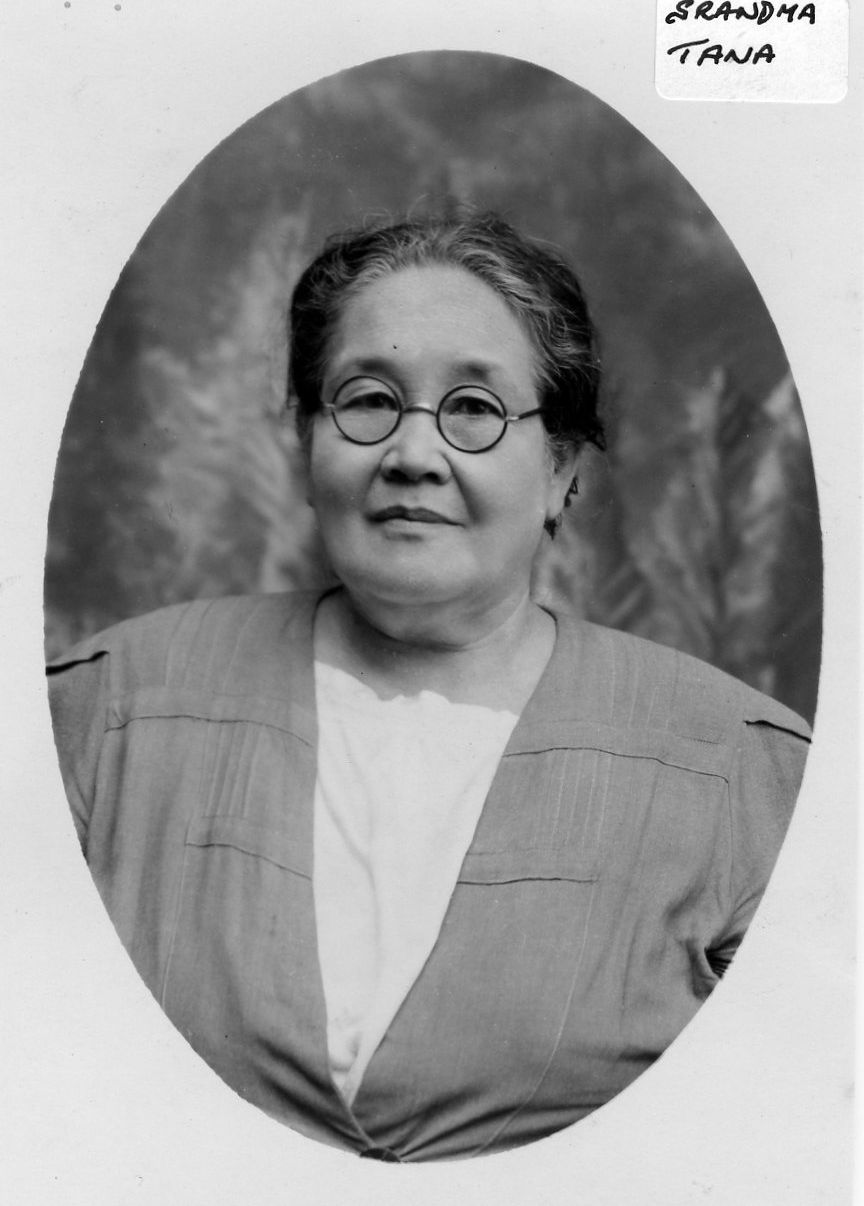
A full blood Chinese is often called in Mauritius a 32. What would a half bred be? The child born of the union of a Chinese to a non Chinese, a half bred would be a 32/2= 16.
Look at the features of this lady. Surely you can observe from the photo of my Grandmother that she is a 16. Indeed , she was the child of my great grandfather Mr. Ah Fan, a china man married to Josephine Hitié.
Grandmother Anna, also lovingly called Tana in the family, married another china man, another 32 and gave birth to my mother. So by simple genes mathematics, the Chinese content of the genes of my mother, based on 32 would work out to be 16 + 32=48/2= 24.
Since my mother married another 32, I reckon that I should mathematically be 24+32= 56/2=28.
Assuming that my wife is another 32, as we have reason to believe, from her ancestry, my children by the same token would be 28 + 32=60 /2 = 30.
In the final analysis, who cares about the weighting of chineseness in our genes? Does a pure blood Chinese exist? After all, the Hans who are the majority of china, are themselves a metissage of different tribes from various part of China and Mongolia.
Whilst it is interesting to know one’s origin, recognising it to move forward in life is the most important. To dig the cultural richness from the past to live a better present and build a compelling future is my belief.
Never mind the genes count, we have greater cultural richness to tap from our Mauritian environment. First hand exposure to the numerous cultures on our Island is truly a strength which I have availed myself of to build my agility of mind. Mauritians have more than one trick to draw from the various cultures.
October 15th, 2008 — Family stories
From my father’s side the lineage is well known and published. As a matter of fact, in the family we have a book of our ancestry, republished in the 30’s, tracing back all the sons of our branch of Chan since the ancestor elected resident in Meixian. We have a record which tracks 24 generations of sons. We estimate that we have 600 to 650 years of history.
In China, at least in our family, the customs demanded that the ancestor head of the family established a rule to track his descendants. As you probably know all Chinese names are made up of the combination of 3 elements. The first element is the clan’s name: in our case, it is Chan. The second and third elements are either the generation’s name or the person designated and chosen name. In our family by convention, perhaps to create complexity and to make it difficult for foreign parties to decipher, we swap the ranking of the second and third element on each generation. Then a series of names pre-determined by the ancestor, cast in a poem for memorisation purpose, is set and used as an algorithm for the generation elements.
For example my father’s name is composed as 1. The Clan’s name: CHAN, 2. Generation’s name: LIN. 3. Personal chosen name: PAK. By convention for the generation of my father, the generation’ name is placed in third position. Thus the complete name of my father was CHAN PAK LIN.
Any person of the same Clan of the same ancestry would thus be able to situate himself against his peers in relation to the generation’s name. CHAN SOW CHEN is my Chinese name. In my generation, the generation’s name is placed on the second position. All his brothers and cousins will carry SOW placed in second position in their name.
Is not it clever the determination of names from the Chinese tradition? Furthermore one would find balance between imposed rule and the flexibility of individual choice. The generation’s name obeys to set rules, whilst freedom of choice is left to the parents to select a personal element of the name. Harmony is thus achieved by the reconciliation of the immutable rule and personal choice. The YIN YANG balance!
October 14th, 2008 — Family stories, People
Etres entourés et supportés par ses cousins est vraiment un bonheur inouï! C’est ce que j’ai vécu ce dernier week-end. Déjà le samedi, c’était le soir du diner de la famille YIPTONG. Soirée mensuelle de la grande famille qui réunit les oncles, tantes cousins et cousines et petits cousins et cousines, tous descendants de l’ancêtre YIPTONG ou mariés à un descendants. La solidarité familiale a pris une dimension particulière car j’avais passé ce samedi soir à prendre connaissance de l’anecdote malheureuse qui s’est abattu sur un cousin. Beaucoup d’entre nous, en entendant le récit, se sont sentis concerné par l’incident, accablé par les effets néfastes, et ont offert leur service et assistance pour alléger le fardeau du cousin.
Sur une note plus heureuse, par contre j’ai vécu une autre solidarité familiale plus festive : Le soixantième anniversaire de Gerard. Gerard lui-même est issu une famille de 2 enfants mais il en a 4 filles. Organiser une fête pour toute la journée pour 120 personnes requière du travail et de la main-d’œuvre. Il a été gâté par la générosité et supports des ses cousins et cousines pour réussir un anniversaire mémorable. L’équipe organisatrice a imaginé un rallye jalonné des questions et de visites aux différents endroits ou Gerard a vécu, a été à l’école et y à travailler. Cela a ainsi permit aux participants du rallye de vivre le passé de Gerard tout en s’amusant. Je salue le grand travail de recherche qu’il a fallut pour rendre l’exercice intéressant, ludique et instructif. Le soir venu, les 120 invités étaient conviés à un diner et spectacle dans les jardins de sa maison. Les discours, témoignages, et souhaits étaient tous déclinés avec professionnalisme dans une organisation sans faille. L’équipe a su tirer partie des talents des cousins réunis pour rendre la fête agréable, amusante et super !
Cousins…voila quoi ca sert ! Avec des familles de plus et plus moins nombreuses, vive les cousins !






